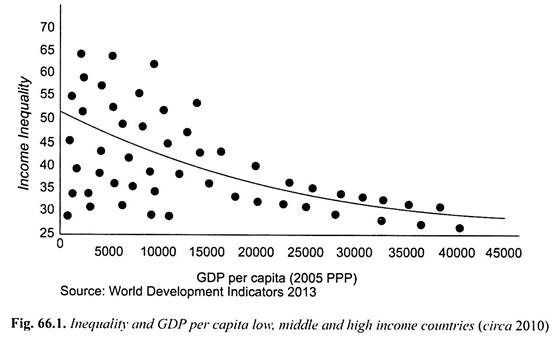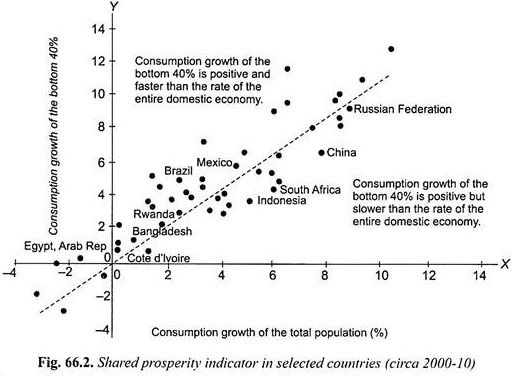The three elements are considered to be central to the notion of shared prosperity are: 1. Shared Prosperity and Economic Growth 2. Equality of Opportunity and Shared Prosperity 3. Opportunities for Various Sections of the Society.
Element # 1. Shared Prosperity and Economic Growth:
Economic growth is thought to be necessary because it ensures an expansion in productive capacity of the economy which when utilised causes increase in the amount of goods and services required for increase in consumption of the people. Therefore, without economic growth, the living standards of the less well-off are unlikely to rise in the medium to the long run.
For example, growth of agriculture will increase the opportunities for a large part of the population (including small farmers and landless labourers). Economic growth is also important because it generates more employment for the people. Like agricultural growth, growth of small and medium enterprises will create higher incomes and larger employment opportunities for the poor people.
But for growth to be inclusive, the priority ought be given in the policy framework that ensures equitable distribution of growth in GDP or national income. The World Bank document on shared prosperity emphasises that for achievement of shared prosperity the growth in incomes should be accompanied by decline in income inequality as has been in the case of many Latin American countries during the past decade (2000-2010) and further that sustained progress in shared prosperity is incompatible will a long-term increase in inequality.
ADVERTISEMENTS:
It is evident from above that there is now distinct shift in the approach to development of the World Bank which along with IMF previously emphasised GDP growth alone in its structural adjustment reforms to be undertaken by the developing countries. Now, it refers to the two empirical research studies at the International Monetary Fund which find that the inequality of incomes is an obstacle to economic growth. Thus one such study finds that high inequality is associated with shorter growth episodes. Similarly, another research study by W. Easterly suggests that structural inequality is a significant barrier to prosperity and growth in per capita income.
More importantly, Ferreira and Ravallion have found that sustained economic growth that raises the welfare of those at the bottom is not compatible with long run increase in income inequality. They point to the fact that in general no country has grown beyond middle income level while maintaining a high level of inequality. This is evident from Fig. 66.1 where data of income inequality and GDP per capita of various countries as shown by various dots representing them.
A trend curve in the data is drawn which clearly shows that in countries with higher GDP per capita income inequality has declined. However, there is large variation in inequality among countries representing low and middle income countries. It further shows that where income inequality is higher promoting shared prosperity will need that income of the bottom 40 per cent grow faster than average income of the population.
It may be noted that for achievement of shared prosperity, income of the bottom 40 per cent of population must rise faster than the growth of the average income of the total population. Thus though growth in GDP is necessary for higher performance in achievement of shared prosperity but it is not a sufficient condition for it. This is because economic growth does not necessarily lead to the gains in incomes of the bottom 40 per cent of population. This is evident from the experience of the United States where per capita income of the bottom 40 per cent of population rose by just 7.5 per cent between 1975 and 2012 while mean income of the total households income increased by 40.5 per cent in the same period.
ADVERTISEMENTS:
The higher initial income inequality is a significant barrier to shared prosperity as well as GDP growth rate. It has been found that in 20 out of 55 developing countries in the decade of 2000-2010, real per capita consumption (or income) of the bottom 40 per cent of the population increased at the average rate of more than 5 per cent annually which is quite satisfactory. It is worth mentioning the empirical findings about the relationship between overall consumption (or income) growth and the consumption (or income) of the bottom 40 per cent of the population.
As will be seen from Fig. 66.2 where data regarding percentage consumption growth of the total population (measured along the X-axis) and consumption growth of the bottom 40 per cent of population (measured along the F-axis) of various countries are plotted; different dots in the figure represent different countries. A trend line has also been drawn which shows that there is a strong and positive relation between consumption of the bottom 40 per cent of population and consumption growth of the total population, This means for achievement of shared prosperity growth in national income or consumption is necessary.
The second important fact revealed by Fig. 66.2 is that in the decade, 2000-2010, 60 per cent of developing countries which include large Latin American Countries of Brazil and Mexico income (or consumption) of the bottom 40 per cent of population increased at a higher rate than the average growth of consumption (or income) of the total population. This could occur only if there was a decline in income inequality. This clearly shows that fall in inequality in income distribution is essential for promoting shared prosperity. It will be seen from Fig. 66.2 that the countries which lies above the trend line such as Brazil, Mexico, though their percentage consumption growth of the total population is low, the percentage consumption growth of the bottom 40 per cent of population is relatively higher.
ADVERTISEMENTS:
Thus the notion of shared prosperity that focuses on growth of bottom 40 per cent of population rather than average rate of GDP growth ensures improvement in living standards or welfare of the less well-off sections of population in a country. It will also be observed from Fig. 66.2 that position of countries such as China, Indonesia, South Africa which lie below the trend line have relatively higher consumption growth of total population but greater income inequality, the consumption growth of bottom 40 per cent of population is lower.
Element # 2. Equality of Opportunity and Shared Prosperity:
To foster shared prosperity requires ensuring equality of opportunity to all people, both children and male adults as well as women. It is only by providing equality of opportunity that production potential of every individual is maximised. Equality of opportunity in childhood and youth requires adequate nutrition, healthcare and education so as to build human capital and raise productivity in the production process.
During adulthood, ensuring equality of opportunity implies imparting appropriate skills and education, the taking care of their health and creation of employment opportunities and providing credit facilities to the young entrepreneurs so that they can set up their micro and small enterprises if not employed on wage basis in the organised sector.
Thus, a World Bank research paper on shared prosperity states that “Efforts to improve and equalise opportunities would lead to immediate rise in welfare along multiple (including non-monetary) dimensions particularly among the poor and the excluded. Over long term, it would also promote social mobility, reduce income inequality and enhance economic dynamism and prosperity for the economy as a whole”.
While the definitions of equality of opportunity by different economists and social thinkers vary significantly but the minimal view is that all children and adults must have access to basic goods and services such as safe water, adequate nutrition and healthcare, primary education so as to maximise human capability. In India, for example, there exists a gender gap in providing basic goods and services so that the girls and women are denied access to education, nutrition, healthcare and employment opportunities. To achieve shared prosperity women must be ensured equal opportunity with men.
Element # 3. Opportunities for Various Sections of the Society:
There are many pathways for achievement of shared prosperity. Economic growth can insure improvement in living standards of bottom 40 per cent of population if it is broad based and generates a lot of opportunities for better quality jobs or gainful employment for all sections of the population. The state has to play a key role in promoting climate for investment in labour-intensive sectors. For generation of employment opportunities the government should link investment allowances to the magnitude of employment created by the industrial enterprises rather than to the amount of capital investment.
Through fiscal incentives, the government should ensure that growth is diversified across multiple sectors. Besides, the Government should ensure “ease of doing business”, improve competitiveness by preventing the emergence of monopolies and oligopolies in the production of goods and services. Besides, for the creation of adequate jobs, the government should encourage innovations or technological changes that are labour-absorptive rather than labour-displacing.
The second pathway to promote shared prosperity is to ensure that growth is inclusive through a specific structure of taxation, government expenditure and social programmes initiated by the government, especially those that make investment in people which build their capabilities and increase productivity and thereby promote economic growth with equity. For fostering shared prosperity, the tax structure should be such that gives incentives to the private sector but at the same time it should ensure equitable distribution of income in a society.
ADVERTISEMENTS:
The third path to promote shared prosperity is to make investment by the government in social institutions so as to ensure equal opportunities for all including the marginalised sections of the society. For this purpose, the World Bank Group emphasizes that rather than redistributing resources from one section of the society to another, the investment should be made for improving the capabilities of the people that increases their productivity and therefore promote growth and equity over time and across generations. With this the people will be able to better their lives on their own.
The evidence furnished by the World Bank Group gives many examples relating to developing countries where inequality of opportunity is still very high and despite growth made by them the circumstances at the time of birth of the individuals, the background and status of their parents, their gender and ethnicity still play a large part in determining his opportunity.
To foster shared prosperity the World Bank document states, “The social contract for promoting equity and growth should aim to create an “opportunity society” where the human and productive potential of every individual regardless of gender, region, ethnicity or parental background is maximised. In childhood and youth, this would imply providing universal access to early childhood development, health, nutrition, education and basic infrastructure to build human capital and increase long-term productivity. This will enhance mobility on the economic and social ladder within and across generations.”
Further, a significant part of social contract aimed at creating conditions to promote shared prosperity is to ensure gender equality. Having equal opportunity with men and same access to facilities of educational healthcare, nutrition, sanitation would enable women to contribute to the best of their abilities in the development process. To quote the said World Bank Document, “Gender equality is not just a core development objective; it also enhances productivity, improves development outcomes for the next generation, and makes institutions more productive.”

